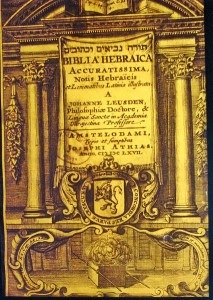The Dead Sea Scrolls and the History of the Jewish Book: Introduction
The complicated process whereby the biblical books took shape and were copied and transmitted in biblical times can only be partly reconstructed based on biblical evidence, with the help of ancient Near Eastern parallels. Clearly, the biblical era constitutes the first stage in the history of the Jewish book, or more correctly, The Jewish book, par excellence. However, for the period immediately following, the Second Temple period, the level of documentation for creating, editing/redacting, and copying and disseminating Jewish books is now enormous due to the discovery, publication and analysis of the Dead Sea Scrolls.[1] While this information relates directly to the period in which the Scrolls were copied, from the last part of the third century BCE through the early first century CE, it does allow us a model with which to supplement our understanding of the biblical period, and much of it is directly relevant to the rabbinic period in which most of the same scribal conventions were in use.
There is one fundamental difference in this regard between the Scrolls and the rabbinic evidence. The sect that gathered the Scrolls and the authors of the non-biblical materials, both apocryphal-pseudepigraphical (i.e., Bible-related) or sectarian (peculiar to the Qumran sect), stem from a writing-oriented culture, in which the ongoing development of the Jewish tradition was a literary activity. The history of Rabbinic literature begins with the Pharisees who revered the books we call biblical, but whose extra-biblical traditions were developed and transmitted orally. While some scholars argue that oral traditions played a role in the development of biblical literature,[2] Second Temple Jews all dealt with biblical books as finished products, albeit not yet completely stabilized as to text or authoritative status.[3] The Pharisees pursued a written-oral culture in which orality characterized their own traditions. Later rabbinic convention initially continued this orality, and developed the full-blown oral Law concept. But later the oral became written and orality became primarily an identifier of the theoretical origins of the “oral” Torah in God’s revelation at Sinai.[4] None of this was of concern to the Dead Sea sectarians who did not accept the Pharisaic “traditions of the Fathers.”[5] For the Qumran sect, all of Jewish law and tradition was derived from the interpretation of the written text of the Bible conducted by the sectarians,[6] and no unwritten traditions were acceptable, except in matters of the organization of the sectarian community.[7]
We will deal below with the following steps in text production as can be gleaned from the Scrolls: composition, editing/redacting, copying, circulation, and gathering and storage.
[1] See the exhaustive study of E. Tov, Scribal Practices and Approaches Reflected in the Texts Found in the Judean Desert (STDJ 54; Leiden: Brill, 2004).
[2] Cf. R. C. Culley, “Oral Tradition and Biblical Studies,” Oral Tradition 1 (1986): 30-65.
[3] E. Tov, “Hebrew Biblical Manuscripts from the Judaean Desert: Their Contribution to Textual Criticism,” JJS 39 (1988):5-37; E. Ulrich, “The Canonical Process, Textual Criticism, and Latter Stages in the Composition of the Bible,” in “Sha’arei Talmon”: Studies in the Bible, Qumran, and the Ancient Near East Presented to Shemaryahu Talmon (ed. M. Fishbane and E. Tov, Winona Lake, IN: Eisenbrauns, 1992) 267-91; L. H. Schiffman, Reclaiming the Dead Sea Scrolls: The History of Judaism, the Background of Christianity, the Lost Library of Qumran (Philadelphia: The Jewish Publication Society, 1994) 161-80.
[4] M.S. Jaffee, Torah in the Mouth: Writing and Oral Tradition in Palestinian Judaism, 200 BCE-400 CE (Oxford: University Press, 2001).
[5] L. H. Schiffman, Texts and Traditions: A Source Reader for the Study of Second Temple and Rabbinic Judaism (Hoboken, NJ : KTAV, 1998) 517-20.
[6] L. H. Schiffman, The Halakhah at Qumran (Studies in Judaism in Late Antiquity 16; Leiden: E.J. Brill, 1975) 75-6.
[7] S. Metso, “Constitutional Rules at Qumran,” in The Dead Sea Scrolls after Fifty Years: A Comprehensive Assessment (ed. J. C. VanderKam and P. W. Flint; 2 vols.; Leiden: E. J. Brill, 1998-1999) 1.186-210.


Very interesting.